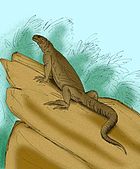Huehuecuetzpalli
| Huehuecuetzpalli Temporal range: Middle to Late Aptian,
| |
|---|---|

| |
| Artist's reconstruction | |
| Scientific classification | |
| Kingdom: | Animalia |
| Phylum: | Chordata |
| Class: | Reptilia |
| Order: | Squamata |
| Suborder: | Iguania (?) |
| Genus: | †Huehuecuetzpalli Reynoso, 1998 |
| Type species | |
| †Huehuecuetzpalli mixtecus Reynoso 1998
| |
Huehuecuetzpalli mixtecus is an extinct lizard from the Early Cretaceous (specifically the middle to late Aptian stage) Tlayúa Formation in Tepexi de Rodríguez, Central Mexico. Although it is not the oldest known lizard, Huehuecuetzpalli may be the most basal member of Squamata (the group that includes lizards and snakes), making it an important taxon in understanding the origins of squamates.[1] It may or may not be a basal member of Iguania, a large clade of lizards that traditionally includes the iguanas and their close relatives, chameleons, and agamids: if it is an iguanian, H. mixtecus represents the earliest major offshoot of the squamate evolutionary tree.[1]
Description[]
Unique characteristics (autapomorphies) of Huehuecuetzpalli include a long pair of premaxilla bones at the tip of the upper jaw that contributes to an elongated snout and the apparent retraction of the external nares or nostril openings. At the top of the skull, a small rounded postfrontal and a hole called the parietal foramen between the junction of the frontal bone and the parietal bone (the frontoparietal suture) suggest affinities with iguanians, but the retention of divided premaxillae, amphicoelous vertebrae (vertebrae that are concave at both ends), thoracolumbar (bones between the vertebrae of the back), an entepicondylar foramen in the humerus (upper arm bone), and a second distal tarsal bone in the foot supports the hypothesis that Huehuecuetzpalli is a basal squamate.[1] A recent study suggests that Huehuecuetzpalli was bipedal.[2]
Taxonomy[]
Huehuecuetzpalli has been suggested to be either a basal squamate or an iguanian. The most parsimonious tree recovered by Reynoso (1998), seen below, recovers it as the outgroup of crown-group squamates:[1]
| Squamata |
| ||||||||||||||||||||||||||||||||||||||||||||||||||||||||||||||||||||||||||||||||||||||||||||||||||||||||||||||||||
| (total group) |
References[]
- ^ a b c d Reynoso, V.-H. (29 March 1998). "Huehuecuetzpalli mixtecus gen. et sp. nov: a basal squamate (Reptilia) from the Early Cretaceous of Tepexi de Rodríguez, Central México". Philosophical Transactions of the Royal Society B: Biological Sciences. 353 (1367): 477–500. doi:10.1098/rstb.1998.0224. JSTOR 56466. PMC 1692218.
- ^ Villaseñor-Amador, Damián; Suárez, Nut Xanat; Cruz, J. Alberto (August 2021). "Bipedalism in Mexican albian lizard (squamata) and the locomotion type in other cretaceous lizards". Journal of South American Earth Sciences. 109: 103299. Bibcode:2021JSAES.10903299V. doi:10.1016/j.jsames.2021.103299. S2CID 233526155.
- Cretaceous lizards
- Reptilia incertae sedis
- Reptiles described in 1998
- Fossil taxa described in 1998
- Fossils of Mexico
- Prehistoric reptile genera
- Prehistoric lizard stubs
